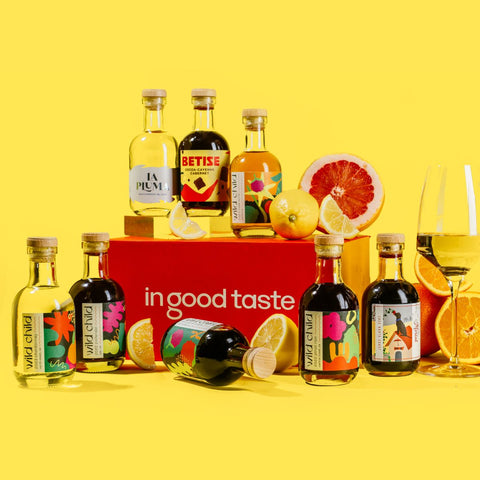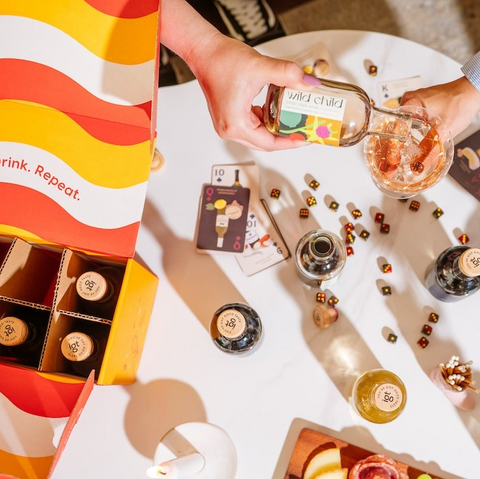Wines That Satisfy Your Sweet Tooth
Maybe it goes without saying, but we think that a good meal just isn’t complete without the perfect glass of wine to compliment the complex flavors of your favorite dish. What can we say – we’re always down for a little wine to enhance every moment! Whether you’re enjoying that delicious vino as an appetizer or with your entree, we believe that our favorite beverage is the perfect addition to any part of a meal – including dessert. In fact, the right wine could even become the dessert itself!
Ladies, gents, and wine lovers of all ages (above 21 years, of course), it’s time to talk about the sweet, decadent world of dessert wines. We’ll get into how these sweet wines are made, the different types of dessert wines from around the globe, and talk about some of our favorite dessert wine pairings.
Ready to satisfy that sweet tooth? Excellent, so are we! Let’s take a closer look at dessert wines, together.
Dessert Wines
As the name suggests, dessert wines are typically enjoyed after a meal as dessert. In the UK, they are sometimes referred to as pudding wines. Many countries have their own unique versions of dessert wines, including Port from Portugal, Sherry from Spain, and Ice Wine from Canada, just to name a few. We’ll get into the specifics of these wines later, but first, we need to discuss just what makes dessert wines so decadent and sweet.
In addition to being much sweeter than your average table wine, dessert wines also have higher alcohol content. This decadence and higher ABV (alcohol by volume) are achieved through a variety of different techniques:

Late Harvest
Grapes that are harvested later in the growing season are more ripe, meaning that they have a higher sugar content and will ultimately result in a sweeter wine.
Fortification
Fortified wines are made when a spirit, such as grape brandy, is added to a wine base. This gives the wines a higher ABV and a longer shelf life. Fortified wines are sometimes referred to as distinct from dessert wines, depending on the type of wine and place of origin.
Noble Rot
Okay, the name is pretty gross, but bear with us. Noble rot is a type of spore called “Botrytis cinerea” that eats fruits and vegetables. Noble rot on grapes adds enticing aromas of ginger, saffron, and honey, adding to the sweetness of a future wine.
Straw Mat
Also called raisin wine, in the straw mat method, grapes are laid out on – you guessed it – a straw mat to raisinate before winemaking. This concentrates the sweetness in the grape before the wine is made.
Now that we know how to make dessert wine, you’re probably wondering … which ones should you try? First, it might be helpful to get acquainted with the different types of dessert wines that you may encounter the next time you’re out wine shopping. Let’s take a look at some of the varietals that you’re likely to see!
Types of Dessert Wines
It seems that many of the wine-famous regions across the world have created their own version of a wine worthy of the dessert title, and each one is created in its own unique way that lends to distinct aromas and flavors. Let’s take a trip around the wine globe to discover a few of the most well-known dessert wines out there!

Madeira
Madeira hails from the Madeira islands off the coast of Portugal, and is made in a unique process that involves oxidizing the wine using heat and aging. Most Madeira (approximately 85% to be exact) produced is made from the red grape Negra Mole. Quality Madeira is a rare find and is prized among serious wine collectors, so it can often be rather costly. When drinking Madeira, expect nutty, sweet notes of walnut oil, hazelnut, peach, and caramel, and has an ABV between 17-22%.

Marsala
Italy’s contribution to the dessert wine scene comes in the form of Marsala, a fortified wine that is best served slightly cool and has an ABV between 15-20%. It comes in a variety of colors, from a buttery golden to a dark ruby shade. It is also a popular wine to cook with in Italian restaurants, especially the well-known dish, chicken marsala.

Port
Port wine originates from Northern Portugal along the ancient Douro River. It is made using a variety of grapes that are native to Portugal, including Souzsa, Touriga Nacional, Touriga Franca, and Tinta Roriz. During fermentation for Port, the wine is strained and blended (or fortified) with a clear grape spirit, resulting in a higher ABV (around 20%) and enhanced shelf life. Ports typically have notes of raspberry, blackberry, and bitter chocolate.

Sherry
Hailing from the Jerez region of Spain, Sherry is a fortified wine that is made from Palimino, Pedro Ximēnez, and Moscatel grapes. During the winemaking process, the wine is intentionally overexposed to oxygen, resulting in a unique array of nutty, briney aromas.
Vermouth
A common ingredient in some of your favorite cocktails, Vermouth is a fortified wine that can either be sweet and red or dry and white. While a dry, white Vermouth is typically found in a Manhattan or a Negroni, we’re going to focus on its sweeter counterpart. The dessert Vermouth, or Italian Vermouth, is red, mildly bitter, slightly sweet, and full-bodied. You can expect Vermouth to have an ABV between 15-18%.
Ice Wine
Typically found in Austria, Germany, and Canada, Ice Wine is a rare type of dessert wine that is only made in years when a vineyard freezes over completely. The grapes must be harvested and pressed while frozen, and have refreshing notes of honey, citrus, and stone fruit. Because of the specific conditions needed to produce ice wine, it can typically be pretty pricey per bottle. The ABV of ice wine is lower than other dessert wines, usually coming in between 8-13%.
Vin de Liqueur
Vin de Liqueur is a type of fortified dessert wine originally made in France. It is made when brandy is added to the unfermented grape must and has an average ABV of 16-22%. While the term originated in France, vin de liqueur is the term used by the European Union to refer to all fortified wines.
Dessert Wine Pairings
While the rich flavors of dessert wine can be easily enjoyed on their own, you can’t go wrong pairing these sweet wines with salty cheeses or a savory charcuterie board. They also compliment the dark, luscious flavors of a layered chocolate cake or creme brulee.
We think that all of these dessert wines sound pretty sweet, don’t you? Consider changing up that after-dinner Cabernet with wine that is truly worthy of dessert status! With so many dessert wines out there to try, you’re sure to discover one that’s as unique and sweet as you are.












